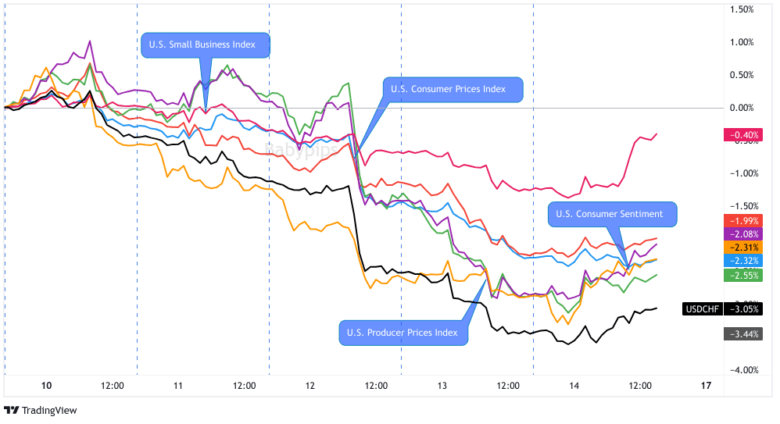It wasn’t the best of weeks for dollar bulls as the U.S. currency found itself trailing behind the forex pack after seeing downbeat inflation data from the U.S.
Not only did these dampen hopes for future Fed rate hikes, but the weak CPI figures also allowed other lower-yielding currencies like the yen and franc to steal the safe-haven spotlight.
Missed the major forex headlines? Here’s what you need to know about last week’s FX scene:
USD Pairs

Overlay of USD vs. Major Currencies Chart by TV
Market jitters ahead of the highly-anticipated U.S. CPI report kept the dollar rangebound early in the week.
It wasn’t long before risk appetite picked up on expectations of subdued inflation data, causing the safe-haven dollar to trend lower ahead of the actual release. The official figures even fell short of consensus estimates, sparking an even sharper USD selloff on Wednesday.
Another wave lower ensued after the PPI readings were printed the next day, as lower than expected producer price gains pointed to consumer inflation slowing much further in the coming months.
? Bullish Headline Arguments
NFIB Small Business Index improved from 89.4 to 91.0 in June, outpacing the consensus at 89.9, to reflect a pickup in optimism
Initial jobless claims fell further to 237K from earlier 249K figure vs. estimated 251K reading
Federal Reserve Vice Chair for Supervision Michael Barr said on Monday that a couple of more hikes are likely needed in 2023
U.S. Treasury Secretary Yellen met with Chinese officials in “direct and productive” discussions of economic and political issues
Preliminary U.S. Consumer Sentiment for July: 72.6 (64.5 forecast; 64.4 previous); short-term inflation expectations ticked up from 3.3% to 3.4%
? Bearish Headline Arguments
Atlanta Fed President Bostic said on Monday that the Fed can be more patient with signs of an economic slowdown appearing
Consumer credit slowed from $20.3 billion to $7.2 billion in May, its two-year low, instead of rising to the estimated $21.1 billion figure
IBD/TIPP Economic Optimism index slipped from 41.7 to 41.3 vs. estimated climb to 45.3 in July, reaching its lowest level in eight months
Headline CPI showed a 0.2% m/m gain in June vs. estimated 0.3% uptick, bringing year-over-year rate down from 4.0% to 3.0% vs. the projected 3.1% reading. Core CPI up by 0.2% m/m vs. 0.3% consensus
Headline and core PPI posted meager 0.1% m/m upticks in June vs. projected 0.2% gains, May readings downgraded to show 0.4% decline in headline figure and 0.1% increase in core reading
EUR Pairs

Overlay of EUR vs. Major Currencies Chart by TV
The shared currency chalked up a mixed performance for the week, as the lack of major catalysts from the eurozone left it functioning mostly as a counter currency and arguably closing out slightly in the green.
? Bullish Headline Arguments
Italian industrial production rebounded 1.6% m/m in May, following earlier 2.0% decline and surpassing the estimated 0.6% uptick
ECB monetary policy meeting accounts pointed to the likelihood of another interest rate hike in July, thanks to optimistic growth outlook and upgraded 2024 inflation forecasts
? Bearish Headline Arguments
Sentix investor confidence index slumped from -17.0 to -22.5 vs. -18.0 forecast in July, reflecting stronger pessimism among investors and analysts
German ZEW economic sentiment index tumbled from -8.5 to -14.7 vs. -10.7 forecast in July, eurozone ZEW economic sentiment index down from -10.0 to -12.2 vs. -10.2 estimate
Industrial production posted a bleak 0.2% m/m uptick in May, short of the estimated 0.3% gain
Germany Wholesale Prices for June 2023: -2.9% y/y (-4.1% y/y forecast; -2.6% y/y previous)
Euro area international trade balance for May 2023: -€0.3B (-€9.4B forecast; -€12.0B previous)
GBP Pairs

Overlay of GBP vs. Major Currencies Chart by TV
Sterling was also one of the weaker-performing currencies of the week as mixed jobs data and mostly downbeat mid-tier reports weighed it down.
Although GBP was able to score a pretty strong lead versus the dollar and Loonie, it looks poised to end in the red against the rest of its forex counterparts.
? Bullish Headline Arguments
BRC retail sales monitor accelerated from 3.7% to 4.2% y/y in July, short of the estimated 4.6% increase but still indicative of a pickup in retail spending
Average earnings index accelerated to 6.9% over the three-month period ending in May, outpacing the consensus at 6.8%. Earlier reading upgraded from 6.5% to 6.7%
May GDP report posted a smaller 0.1% dip in economic activity vs. estimated 0.3% m/m decline
? Bearish Headline Arguments
BOE Governor Bailey reiterated that inflation remains “unacceptably high” but expects inflation to “fall markedly over the remainder of the year”
Claimant count change came in at 25.7K vs. 20.5K estimate in June, May reading upgraded to show larger 22.5K drop in joblessness vs. initially reported 13.6K decline, jobless rate up from 3.8% to 4.0%
RICS house price balance fell from -30% to -46% vs. -35% to signal that more property surveyors are reporting price declines in their areas
Goods trade deficit widened from 14.6 billion GBP to 18.7 billion GBP vs. projected 14.9 billion GBP shortfall, as imports rose 4.2% m/m in May while imports fell 4.4%
Industrial production slumped 0.6% vs. 0.4% m/m estimated decline in May, manufacturing production down by 0.2% m/m
Bank of England Credit Conditions Survey for Q2 2023: The availability of secured and unsecured credit to households is expected to decline in Q3 2023 but remain stable for businesses.
CHF Pairs

Overlay of CHF vs. Major Currencies Chart by TV
The Swiss franc is currently in the lead this week, as the lack of major economic data seemed to work out in its favor.
Its only main rival for the top spot is the Japanese yen, as CHF/JPY moved gradually lower then sideways for the most part of the week before picking up on a strong uptrend during the latter half.
? Bullish Headline Arguments
Switzerland Producer Prices Index for June 2023: 0.0% m/m (-0.4% m/m forecast; -0.3% m/m previous)
AUD Pairs

Overlay of AUD vs. Major Currencies Chart by TV
The Aussie is arguably a net loser against most of its forex counterparts as improvements in business and consumer sentiment indices wasn’t enough to keep it in the green against most of the majors.
After a bit of a rocky start and some consolidation midweek, the commodity currency popped higher when the U.S. CPI came up short and eased some concerns about rising global borrowing costs.
But the addition of downbeat inflation and trade activity data from China may have drawn in more sellers than buyers, at least against the currencies who weren’t seeing massive selling press of their own this week.
? Bullish Headline Arguments
Westpac consumer sentiment posted 2.7% increase in July, a significant improvement over the earlier 0.2% uptick
NAB business confidence index climbed from -3 to 0 to reflect a shift away from pessimism in June
New loan growth accelerated in China to ¥3.05T in June (¥2.9T forecast) vs. ¥3.05T from ¥1.36T in May
MI inflation expectations unchanged at 5.2% in June, suggesting price pressures could remain anchored over the next 12 months
? Bearish Headline Arguments
China’s headline CPI slowed from 0.2% to 0.0% y/y in June vs. estimated 0.2% figure, Chinese PPI fell by 5.4% y/y vs. 5.0% forecast and earlier 4.6% slump
Chinese trade surplus widened from $65.8B to $70.6B vs. $90.0B forecast, exports declined by -12.4% y/y in June (-6.1% y/y forecast; -7.5% y/y previous); the largest decline in over three years
CAD Pairs

Overlay of CAD vs. Major Currencies Chart by TV
Next to the U.S. dollar, the Loonie also fell behind the rest of the forex gang during the week, even after the BOC hiked interest rates as expected.
Although there was a bit of hawkish tilt to their actual statement, the Canadian dollar was seeing red leading up to and after the event, and had trouble pulling up for the rest of the week.
The initial selloff correlated with the weak U.S. CPI release, so the bearish argument could be that because of their close geography/trading relationship, the U.S. inflation read could be a signal of Canadian inflation updates we may see, as soon as next week.
Whatever the case may be, it was an awful week for Loonie bulls despite higher oil prices and net positive Canadian updates.
? Bullish Headline Arguments
Building permits rebounded by 10.5% m/m vs. 7.3% forecast in May, following earlier reading which was downgraded from -18.5% to -20.1%
BOC hiked interest rates by 0.25% from 4.75% to 5.00% as expected, keeping the door open for future rate hikes on stubborn inflationary pressures and upgraded economic forecasts
BOC Monetary Policy Report: The BOC forecasts inflation staying around 3% for the next year, and returning to the 2% target by mid-2025
During the presser, BOC Governor Macklem highlighted labor market tightness and willingness to keep hiking interest rates
Canada manufacturing sales for May 2023: +1.2% m/m (+0.8% m/m forecast; -0.1% m/m previous)
NZD Pairs

Overlay of NZD vs. Major Currencies Chart by TV
Even though the RBNZ delivered on its widely-expected rate hike pause for the month, the Kiwi still managed to maintain quite the lead against majority of its peers this week.
Its general bearish trend from the first half of the week turned a corner after the U.S. CPI was released. NZD raked in its largest gains versus USD and CAD while retaining small dents against JPY and CHF.
? Bullish Headline Arguments
Food price index rose from 0.3% m/m uptick in May to a 1.6% gain in June, suggesting slightly stronger inflationary pressures later on
? Bearish Headline Arguments
RBNZ kept interest rates on hold at 5.50% as expected, citing that “level of interest rates are constraining spending and inflation pressure as anticipated and required”
Visitor arrivals slowed further from a 16.9% m/m slump in April to a 27.5% drop in May
BusinessNZ manufacturing index down from 48.7 to 47.5 in June, reflecting sharper contraction in the industry
JPY Pairs

Overlay of JPY vs. Major Currencies Chart by TV
The lower-yielding yen took advantage of dollar weakness and yen-tervention jitters to end up in second place next to the franc this week.
Mid-tier economic data was actually downbeat, but yen bulls were charging early on, sparking a sustained uptrend for the Japanese currency for the first half of the week.
JPY was able to sustain its rally against the dollar throughout, but wound up returning a few gains to its other forex peers when the U.S. CPI triggered a risk rally.
? Bearish Headline Arguments
Bank lending slowed from 3.4% to 3.2% y/y in June vs. estimated 3.5% figure
Current account surplus narrowed from 1.90 trillion JPY to 1.70 trillion JPY vs. 1.87 trillion JPY forecast in May
Economy Watchers sentiment index fell from 55.0 to 53.6 vs. 54.8 forecast in June, suggesting weaker optimism among workers
Core machinery orders slowed by 7.6% m/m in May vs. projected 0.9% uptick, erasing earlier 5.5% gain
Producer prices slumped from 5.2% y/y to 4.1% in June vs. 4.3% forecast, marking sixth consecutive monthly slowdown
Japan Industrial Production for May 2023: -2.2% m/m (-1.6% forecast; 0.7% m/m previous)









